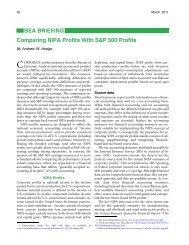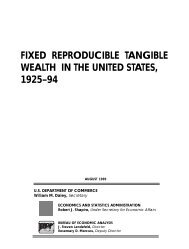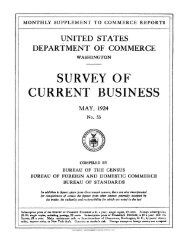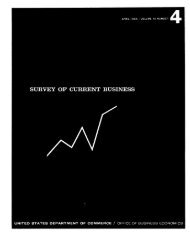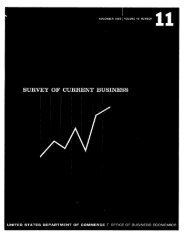current business statistics - Bureau of Economic Analysis
current business statistics - Bureau of Economic Analysis
current business statistics - Bureau of Economic Analysis
Create successful ePaper yourself
Turn your PDF publications into a flip-book with our unique Google optimized e-Paper software.
Bank Reserves and Bank Credit<br />
Billion $ (Ratio scale)<br />
40<br />
25 —<br />
600<br />
500<br />
400<br />
360<br />
320<br />
280<br />
240<br />
220<br />
120<br />
100<br />
80<br />
60<br />
50<br />
40<br />
BANK CREDIT<br />
Total<br />
Other<br />
$ecurities<br />
-U.S. G wernment<br />
Serurities<br />
1968 1969 1970 1971<br />
Seasonally Adjusted<br />
U.S. Department <strong>of</strong> Commerce, <strong>Bureau</strong> <strong>of</strong> <strong>Economic</strong> <strong>Analysis</strong><br />
GHART 1<br />
1972<br />
Data: FRB<br />
the BUSINESS SITUATION<br />
72-2-1<br />
JL HE monetary authorities have<br />
moved in recent months to achieve a<br />
more stimulative credit policy and<br />
conditions in money and credit markets<br />
have eased considerably. The Federal<br />
Reserve's open market committee,<br />
which formulates monetary policy,<br />
voted on November 16 u to promote<br />
somewhat greater growth in monetary<br />
and credit aggregates,"• and on December<br />
14 "to promote the degree <strong>of</strong> ease in<br />
bank reserves and money market conditions<br />
essential to greater growth in<br />
monetary aggregates over the months<br />
ahead." These positions have a clearly<br />
more stimulative thrust than the positions<br />
taken in late September and October,<br />
when the committee set policy for<br />
"moderate growth in monetary and<br />
credit aggregates."<br />
The <strong>current</strong> stance <strong>of</strong> monetary<br />
policy was confirmed at mid-February<br />
by the Federal Reserve chairman.<br />
He stated that the Federal Reserve<br />
intends to see that supplies <strong>of</strong> money<br />
and credit are sufficient to finance the<br />
accelerated growth <strong>of</strong> national output<br />
expected this year, and that the Reserve<br />
has no intention <strong>of</strong> allowing the<br />
economic recovery to falter for want <strong>of</strong><br />
money or credit.<br />
Rates and yields<br />
The <strong>current</strong> decline in short-term<br />
rates began last August, when the New<br />
<strong>Economic</strong> Policy was introduced, and<br />
gathered momentum in December and<br />
January. By mid-February most shortterm<br />
rates had declined roughly 2<br />
percentage points from their highs <strong>of</strong><br />
last summer. The Treasury bill yield<br />
and the Federal funds rate were well<br />
below 3% percent and the rates on prime<br />
commercial paper and bankers' acceptances<br />
were below 4 percent. On<br />
February 15, the commercial banks 7<br />
prime loan rate was cut further to 4%<br />
percent. This rate has been reduced \%<br />
percentage points (in six steps) from<br />
last summer and is at its lowest level<br />
since the early 1960's. The decline in<br />
short-term rates has been sufficiently<br />
strong to carry through to consumer<br />
loan rates, which tend to be rather slow<br />
to respond to changes in overall credit<br />
conditions. In early February several<br />
major banks on the West Coast announced<br />
further cuts <strong>of</strong> about.% percentage<br />
point on most categories <strong>of</strong><br />
consumer loan rates.<br />
In long-term markets, yields have<br />
declined only modestly from last summer's<br />
highs. By early February, yields<br />
on long-term U.S. Government securities<br />
had declined less than % percentage<br />
point, yields on corporate Aaa bonds<br />
about % percentage point, and municipal<br />
yields about % point. The decline in<br />
long-term yields had for the most part<br />
ended by early November, and the<br />
small declines that occurred thereafter<br />
have been erased by the moderate upturn<br />
in rates associated with the news<br />
inlate January that the estimated budget<br />
deficit for fiscal 1972 is now much<br />
larger than had been expected. Market<br />
participants were apparently expecting<br />
a deficit in the unified budget in the



